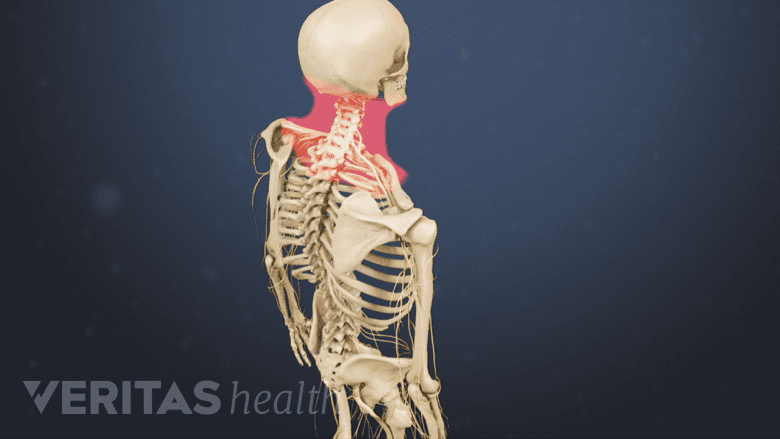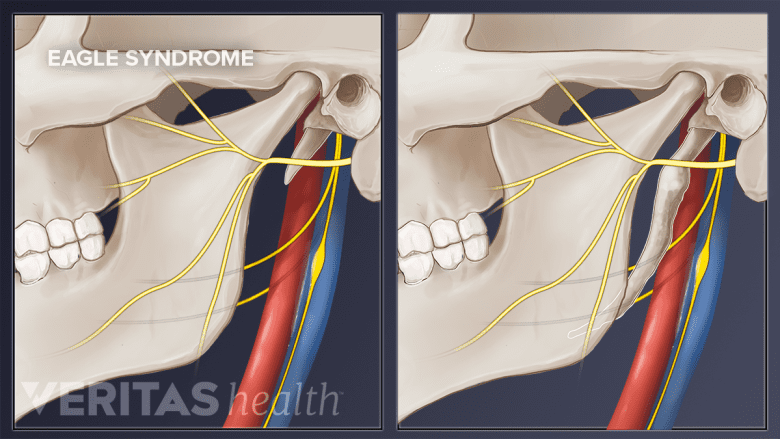When the skull’s styloid process—the pointy bone below the ear—becomes elongated in a manner that pushes against a nerve or blood vessel, it can result in Eagle syndrome. Common symptoms include potentially severe pain in the face, throat, and/or neck.
Various factors are thought to cause Eagle syndrome, ranging from trauma, genetic predisposition, and complications from surgery in a nearby region, among others. It should also be noted that sometimes Eagle syndrome results from calcification of the ligament attached to the styloid process or an abnormally angled styloid process.
In This Article:
Common Symptoms

Eagle syndrome can lead to various levels of throat pain, ranging from dull aches to unbearable discomfort.
Common symptoms of Eagle syndrome can include one or more of the following:
- Throat pain that can range from dull and nagging to excruciating or burning. There could also be a sensation of food or something in the throat even when there is not.
- Neck and/or face pain that can also be felt in the jaw or ear, and may become intense or sharp.
- Ringing sound in the ear, also known as tinnitus.
- Increased pain with head movements, such as rotating the head, moving the tongue, or chewing.
Less commonly, Eagle syndrome can cause severe headaches.
How Eagle Syndrome Causes Neck Pain

The skull’s styloid process is the anchor bone where some muscles of the tongue and larynx (voice box) attach. A healthy styloid process can move freely and do its job without disturbing any critical structures or tissues. However, an elongated styloid process (or calcified or abnormally angled styloid process) could start pushing into nearby structures, such as:
- Nerves. There are several nerves near the skull’s styloid process, including the glossopharyngeal nerve (travels through neck, part of tongue and middle ear), vagus nerve (long nerve, including traveling through the neck and into the face), hypoglossal nerve (travels to tongue), and facial nerves. If a nerve becomes irritated by the styloid process, neck pain can occur from local inflammation or pain that is referred.
- Blood vessels. The internal carotid artery (supplies blood to brain) and internal jugular vein (returns blood to heart from brain, face, and neck) both run near the styloid process. If a blood vessel is compressed by the styloid process, neck pain can occur from local inflammation or a reduction in blood circulation. Eagle syndrome resulting from blood vessel compression is more likely to cause a severe headache than neck pain.
Eagle syndrome is usually caused by an irritated nerve rather than an irritated blood vessel.
Diagnosis
Eagle syndrome is diagnosed based on a two-step process:
- Physical exam. The doctor will take the patient’s medical history, learn about his or her symptoms, and then examine the neck and inside the mouth.
- CT scan. This imaging technique uses a computer to piece together multiple X-ray images to form cross-sections of the body that can show bones and calcifications in great detail. Some medical facilities have 3D CT to create images in three dimensions, which can be especially helpful in diagnosing the elongated stylus process of Eagle syndrome and planning for surgery.
It should also be noted that Eagle syndrome’s symptoms can be similar to other problems and is typically not a quick diagnosis. Other potential causes—such as oral, dental, or jaw problems—must be considered as well.
Treatment

Eagle syndrome requires surgery to remove the elongated or problematic portion of the styloid process.
Eagle syndrome typically requires surgery in order for the patient to find adequate relief from symptoms. Surgery to remove the elongated or problematic portion of the stylus process can be done one of two general ways:
- Intraoral approach. The surgeon approaches the styloid process through the mouth.
- Extraoral approach. The surgeon approaches the styloid process through an incision in the upper part of the neck on the side that is causing the problem.
Reported success rates for Eagle syndrome surgery vary widely. However, recent advances in surgery appear to be producing better results than in the past.
For patients who are able to tolerate symptoms and/or are not good candidates for surgery, Eagle syndrome may also be treated with nonsteroidal anti-inflammatory drugs (NSAIDs), or local injections of steroids (to reduce inflammation) or anesthetics (to block pain). Results can vary from person to person, and multiple options may need to be tried to determine which treatment is most effective.

